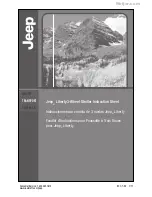
© Digital View Ltd 2011
www.digitalview.com
Page 4 of 38
ASSEMBLY NOTES
This controller is designed for monitor and custom display projects using 1600x1200 or 1366x768 or 1280x1024 or 1280x800 or
1280x768 or 1024 x 768 or 800x600 or 800x480 or 640x480 resolution TFT panels with a VGA, SVGA, WXGA, XGA, SXGA or
UXGA signal input. The following provides some guidelines for installation and preparation of a finished display solution.
Preparation
: Before proceeding it is important to familiarize yourself with the parts making up the system and the various
connectors, mounting holes and general layout of the controller. As much as possible connectors have been labeled. Guides
to connectors and mounting holes are shown in the following relevant sections.
1.
LCD Panel
: This controller is designed for typical LVDS or TTL single interface panels with panel voltage 3.3V, 5V or 12V
or 18V. Due to the variation between manufacturers of panels signal timing and other panel
characteristics, factory setup
and confirmation should be obtained before connecting to a panel.
(NOTE: Check panel power jumper settings before
connection)
2.
Controller
: Handle the controller with care as static charge may damage electronic components. Make sure correct
jumper and dip switches settings to match the target LCD panel.
3.
LCD signal cable (Single pixel TTL panel)
: In order to provide a clean signal it is recommended that LCD signal cables
should not longer than 33cm (13 inches). If loose wire cabling is utilized these can be made into a harness with cable ties.
Care should be taken when placing the cables to avoid signal interference. Additionally it may be necessary in some
systems to add ferrite cores to the cables to minimize signal noise.
4.
LCD signal cable (LVDS panel)
: In order to provide a clean signal it is recommended that LVDS signal cables are no
longer than 46cm (18 inches). If those wire cabling is utilized these can be made into a harness with cable ties. Care
should be taken when placing the cables to avoid signal interference. Additionally it may be necessary in some systems to
add ferrite cores to the cable to minimize signal noise.
5.
Inverter
: This will be required for the backlight of an LCD, some LCD panels have an inverter built in. As LCD panels may
have 1 or more backlight tubes and the power requirements for different panel backlights may vary it is important to match
the inverter in order to obtain optimum performance. See Application notes page 18 for more information on connection.
6.
Inverter Cables
: Different inverter models require different cables and different pin assignment. Make sure correct cable
pin out to match inverter. Using wrong cable pin out may damage the inverter.
7.
Function Controls
: The following section discusses the controls required and the section on connectors provides the
detail. The controls are minimal: On/Off, Backlight Brightness (depends on inverter), OSD (5 momentary buttons) analog
VR type or (8 momentary buttons) digital type.
8.
Function controls cable
:
The cables to the function switches should be of suitable quality and length so that impedance
does not affect performance. Generally lengths up to 1 meter (3 feet) should be acceptable.
9.
Status
LED
: The pin direction of the LED should be corrected for right colour indication. Red colour stands for standby.
Green colour stands for signal on. The status LED is an optional part only, can be unconnected.
10.
IR
sensor
: It is an optional part only, can be unconnected if not using IR remote control.
11.
Audio
add-on
board
: Provide the interface for the audio add-on board to be connected. The audio add-on board gives
the audio input and output signal connection. But the volume cannot be controlled by the OSD menu on the controller. It is
an optional part only, can be unconnected if not using audio.
12.
VGA
Input
Cable
: As this may affect regulatory emission test results and the quality of the signal to the controller a
suitably shielded cable should be utilized.
•
AV
cables
: Standard Composite or S-video cables can be used. Reasonable quality cable should be used to avoid image
quality degradation.
13.
DVI-D input cable :
Plug the DVI cable to the connector P2 on the controller board.
14. Alternate video input for S-Video and composite video
15. HD/SD component video input
: Plug the component video input signal on CNV2 connector
•
Power Input
: 12V/24VDC is required, this should be a regulated supply. The power rating is depending on the panel and
inverter used. Normally, power supply with 3.5Amp current output should enough for most of 4x CCFT panels. Although the
controller provides power regulation for the LCD power this does not relate to the power supplied to the backlight inverter. If an
unregulated power supply is provided to an inverter any fluctuations in power may affect operation, performance and lifetime of
the inverter and or backlight tubes.
•
Power
output
: Note the controller has an overall 3Amp current limit and the current available from the auxiliary power
output will be dependent on the power input and other system requirements.
•
Power
Safety
: Note that although only 12VDC / 24VDC is required as ‘power-in’ a backlight inverter for panel backlighting
produces significantly higher voltages (the inverter does not connect to the ground plane). We strongly advise appropriate
insulation for all circuitry.





































